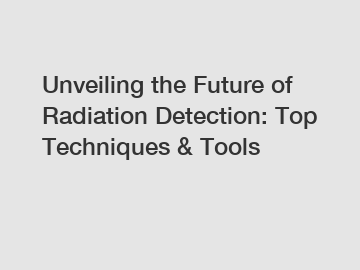Unveiling the Future of Radiation Detection: Top Techniques & Tools
Unveiling the Future of Radiation Detection: Top Techniques & Tools?
As technology advances at an unprecedented rate, it's essential to discuss the future of radiation detection. How will we protect ourselves from potentially harmful radiation in the years to come? This article explores the top techniques and tools that could shape the future of radiation detection.
1. The importance of radiation detection:

Radiation is present in various forms and can be emitted during nuclear accidents, in medical procedures, or even in natural sources. Understanding and detecting radiation are crucial for public safety, environmental protection, and medical advancements. By unveiling the future of radiation detection, we can ensure that we are equipped to handle potential risks.
2. Miniaturization and portability:
One of the significant advancements in radiation detection technology is miniaturization. Traditional radiation detection devices were bulky and required specialized training to operate. However, recent developments have led to the creation of portable and user-friendly devices. These new tools allow for improved mobility, making radiation detection more accessible in various situations.
3. Advanced spectroscopy techniques:
Radiation detection devices rely heavily on spectroscopy techniques to determine the type and energy of radiation emitted. Traditional spectroscopy methods were time-consuming and required high-tech equipment. But with recent advancements, new spectroscopy techniques have emerged, offering faster and more accurate readings. Techniques such as gamma-ray spectroscopy, scintillation detectors, and neutron detectors are enhancing the capabilities of radiation detection devices.
4. Integration of artificial intelligence:
Artificial intelligence (AI) is revolutionizing various industries, and radiation detection is no exception. AI algorithms can aid in the analysis and interpretation of radiation data, thereby improving detection accuracy. Machine learning algorithms can effectively identify patterns and anomalies, enabling swift identification of potential radiation threats. Integrating AI with radiation detection devices can enhance their capabilities and provide real-time monitoring and alerts.
5. Wireless connectivity and IoT integration:
Advancements in wireless technology and the Internet of Things (IoT) have opened up new possibilities for radiation detection. Connected devices can collect and transmit radiation data in real-time, allowing authorities to monitor radiation levels remotely. This integration of IoT with radiation detection devices can lead to faster response times during emergencies and enable constant monitoring of radiation levels in high-risk areas.
6. Nanotechnology for enhanced sensitivity:
Nanotechnology is another area that holds significant promise in radiation detection. By leveraging the properties of nanoparticles, researchers can enhance the sensitivity and accuracy of detection devices. Nanoscale sensors can offer improved detection limits, enabling the identification of even the smallest amounts of radiation. As nanotechnology continues to advance, radiation detection tools utilizing this technology may become more readily available.
7. Unmanned aerial vehicles (UAVs) for radiation mapping:
Unmanned aerial vehicles, commonly known as drones, are being increasingly used for various applications, including radiation mapping. Equipped with radiation detection devices, UAVs can swiftly cover large areas and collect data on radiation levels. This technology allows for efficient monitoring of radiation hotspots, especially in hazardous or difficult-to-access areas. UAVs can provide valuable information to authorities, enabling them to make informed decisions in emergency situations.
In conclusion, the future of radiation detection looks promising with advancements in miniaturization, advanced spectroscopy techniques, integration of artificial intelligence, wireless connectivity, nanotechnology, and the use of UAVs for radiation mapping. These technologies have the potential to make radiation detection more accessible, efficient, and accurate, ultimately ensuring public safety and minimizing potential risks. As we move forward, it's crucial to continue investing in research and development in this field to stay prepared for any future challenges involving radiation. So, how will you contribute to unveiling the future of radiation detection?
If you are looking for more details, kindly visit acousto-optic q-switch driver, radiation detection and measurement solutions, introduction to radiation detectors.
205
0
0

Comments
All Comments (0)